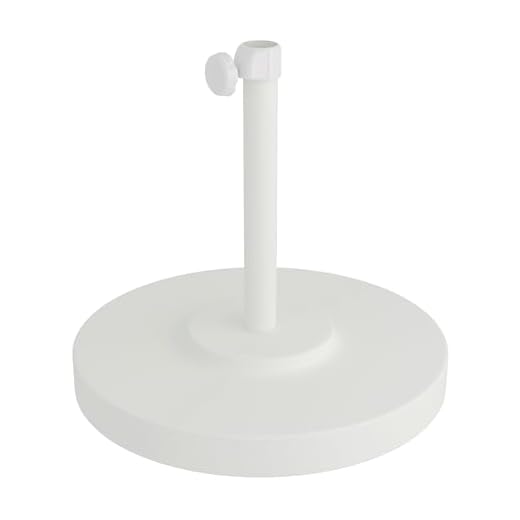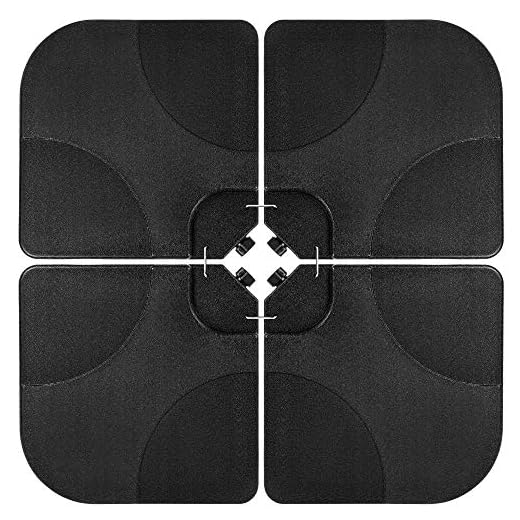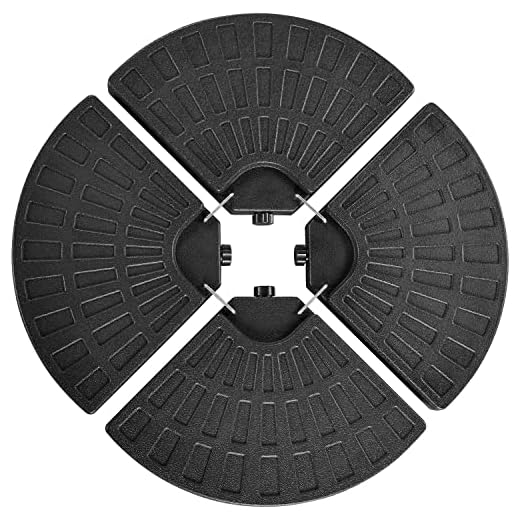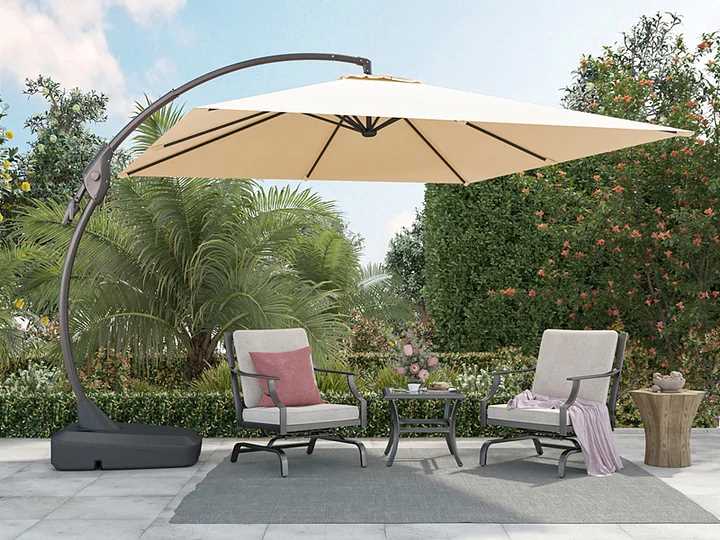




For optimal stability, a weight of at least 50 pounds is recommended to anchor your outdoor shade structure securely. This ensures it withstands wind and shifting weather conditions, providing reliable coverage during warm days.
This article is designed for homeowners and outdoor enthusiasts looking to enhance their patio or garden space. Selecting the appropriate support will help prevent accidents and ensure your shade solution remains upright and functional.
We’ll explore various options, including concrete blocks, water-filled bases, and sandbags, discussing their pros and cons. Additionally, tips on placement and maintenance will be provided to maximize the longevity of your purchase.
Choosing the Right Support for Your Outdoor Canopy
For optimal stability, it is recommended to use heavy bases designed specifically for outdoor canopies. The weight of these supports can significantly impact the overall performance, especially in windy conditions. A minimum of 100 pounds is often suggested for smaller structures, while larger canopies may require upwards of 200 pounds.
Materials used in these supports can vary, but options like concrete, steel, or plastic filled with sand or water provide excellent stability. Each material has its own advantages, such as durability and resistance to rust or corrosion, which are essential for outdoor use.
Factors to Consider
- Size of the Canopy: Larger canopies necessitate heavier bases to withstand wind forces.
- Wind Conditions: In areas prone to strong gusts, opting for additional weight is prudent.
- Base Shape: Square or rectangular bases offer better coverage and stability compared to circular ones.
- Mobility: If frequent repositioning is needed, consider a design that allows for easy transport.
In addition to weight, the design of the support system can enhance stability. Options that allow for additional weight attachments provide flexibility and security. Always ensure that the support is compatible with the specific model of your outdoor structure to achieve the best results.
Choosing the Right Material for Umbrella Weights
Selecting the appropriate material for securing your outdoor shade structure is essential for stability and durability. Commonly used materials include concrete, steel, and plastic, each offering distinct advantages and disadvantages.
Concrete provides substantial weight and stability, making it a popular choice. However, its bulkiness can complicate transportation and storage. Steel offers strength and resistance to rust, but may require additional coating for protection against the elements. Plastic options are lightweight and easy to handle, but may not provide the same level of stability in windy conditions.
Material Characteristics
- Concrete: Heavy and stable, suitable for windy areas.
- Steel: Durable and rust-resistant but heavier than plastic.
- Plastic: Lightweight and portable, but potentially less stable.
When choosing a material, consider the environment where the shade structure will be used. If the location is prone to strong winds, heavier materials like concrete or steel are advisable. For casual use in calm conditions, lighter options may suffice.
Additionally, think about maintenance. Concrete may require occasional cleaning, while steel may need rust protection. Plastic can fade over time but is often easier to clean and maintain. Choose a material that fits both your usage needs and your willingness to perform upkeep.
Calculating the Required Weight for Stability
The stability of a freestanding shade structure significantly depends on the mass used at its base. To ensure that the installation withstands wind and other environmental factors, the following guidelines should be considered.
First, assess the size of the canopy. A larger canopy will require more mass to maintain balance. A general rule is to use approximately 10% of the total area of the canopy in weight. For example, if the canopy measures 10 square feet, aim for about 1 square foot of weight distributed evenly across the base.
Factors Influencing Required Mass
- Wind Conditions: In areas with frequent strong winds, increase the mass proportionately. For every additional 10 mph of wind speed, consider adding another 20% to the required mass.
- Material of the Base: Heavier materials, such as concrete or filled bases, provide greater stability than lighter options like plastic.
- Height of the Structure: Taller shades may need more mass at the base to prevent tipping. A height increase of 2 feet could necessitate an additional 15% mass.
Always ensure that the weight is evenly distributed to avoid any imbalance that might lead to tipping. Regularly inspect the base for wear and tear, and replace or add mass as needed to maintain stability.
Comparing Different Weight Designs and Their Effectiveness
The choice of support mechanisms for shade structures significantly influences stability and performance. Various designs offer distinct benefits that can enhance durability and resistance against wind forces.
Round and square bases are among the most common shapes, each providing unique advantages. Round bases tend to distribute weight evenly, which can be beneficial for maintaining balance. Conversely, square bases often offer a larger surface area, making them less prone to tipping in gusty conditions.
Material Considerations
When evaluating support structures, materials play a critical role in performance. Concrete, plastic, and metal bases each have unique characteristics:
- Concrete: Known for its substantial weight, concrete provides excellent stability but may be cumbersome to relocate.
- Plastic: Lightweight and often filled with sand or water, plastic options are portable but may lack durability in extreme weather.
- Metal: Steel or cast iron options deliver strength and longevity, often designed to resist rust and corrosion.
Shape and Design Variations
The design of the base affects not only aesthetic appeal but also functional attributes. Some options incorporate a hollow design that allows for filling with sand or water, providing flexibility in weight adjustment. Others may feature decorative elements that enhance visual appeal while maintaining stability.
- Hollow bases for customizable weight.
- Decorative styles for aesthetic enhancement.
- Integrated wheels for easy movement.
In conclusion, selecting appropriate support structures requires careful consideration of shape, material, and design. Each element contributes to the overall performance and usability of the shade solution, ensuring that it remains secure and functional in various conditions.
Maintenance Tips for Long-lasting Umbrella Supports
Regular inspection of your supports is key to maintaining their integrity. Check for any signs of rust, cracks, or wear, and address issues promptly to prevent further damage.
Cleaning the surfaces is equally important. Use a soft cloth and mild soap solution to wipe down the supports, removing debris and preventing corrosion.
Storage Practices
- Store in a dry location to avoid moisture buildup.
- Use protective covers when not in use, especially during inclement weather.
Weight Management
- Ensure the supports are properly filled to prevent instability.
- Check for leaks in any water-filled models and refill as necessary.
Seasonal Checks
- Inspect before the start of each season for any potential issues.
- Apply a rust-inhibiting spray annually to metal components.
Implementing these maintenance tips will significantly extend the lifespan of your umbrella supports, ensuring they remain functional and safe throughout their use.
Best weights for cantilever umbrella
Features
| Part Number | SKY5897 |
| Model | SKY5897 |
| Color | Black |
| Size | Set of 1 |
Features
| Part Number | CFMT160-White |
| Model | CFMT160-WHITE |
| Warranty | 1 year |
| Color | White |
| Is Adult Product | |
| Size | 19.75" x 19.75" x 19" |
Features
| Part Number | FUB41B |
| Model | FUB41B |
| Color | Black |
| Release Date | 2023-12-22T00:00:01Z |
Features
| Part Number | SKY3257 |
| Model | SKY3257 |
| Color | Black |
| Size | 4-Piece |
Features
| Part Number | YT-00101141 |
| Model | YT-00101141 |
| Color | Black |
| Size | 39.5×39.5×3in |
Features
| Part Number | UBP18181-BR |
| Model | UBP18181-BR |
| Warranty | One year warranty on manufacturing defects |
| Color | Bronze |
| Is Adult Product | |
| Release Date | 2024-01-01T00:00:01Z |
| Size | 18-Inch |
Video:
FAQ:
What weight is recommended for a cantilever umbrella?
The recommended weight for a cantilever umbrella typically ranges from 80 to 150 pounds, depending on the size and design of the umbrella. Larger umbrellas require heavier bases to ensure stability, especially in windy conditions. For example, a 10-foot umbrella may need at least 100 pounds of weight, while a 13-foot umbrella might require around 150 pounds to stay grounded. It’s crucial to check the manufacturer’s guidelines for specific recommendations based on the umbrella’s dimensions.
Can I use sandbags as a weight for my cantilever umbrella?
Yes, sandbags can be a practical option for adding weight to a cantilever umbrella. They are often used because they are easy to fill and can provide the necessary stability. However, make sure to secure them properly to prevent shifting or tipping. You can also consider using decorative covers for the sandbags to enhance the aesthetic appeal of your outdoor space.
What materials are best for cantilever umbrella weights?
When choosing materials for cantilever umbrella weights, concrete and steel are among the best options due to their durability and weight. Concrete bases are often molded into various shapes, making them versatile for different designs. Steel weights can provide significant stability and are usually more compact than concrete. Some bases also feature a combination of materials for added strength and design appeal. Always ensure that whatever material you choose can withstand outdoor conditions without deteriorating.
How do I secure the weight to my cantilever umbrella?
Securing the weight to a cantilever umbrella involves a few simple steps. First, place the weight on the base of the umbrella according to the manufacturer’s instructions, ensuring it fits snugly. Many cantilever umbrellas come with a designated weight holder or platform where weights can be stacked or attached. If you’re using sandbags or other loose weights, ensure they are evenly distributed and secured with straps or ties to prevent movement. Regularly check the stability of the weight, especially after strong winds or storms.









